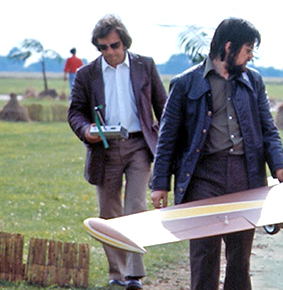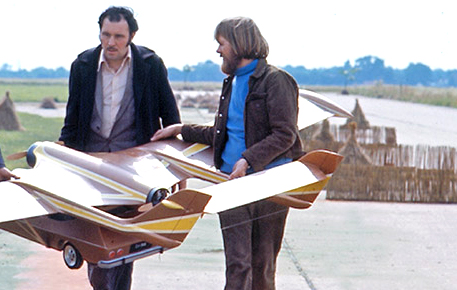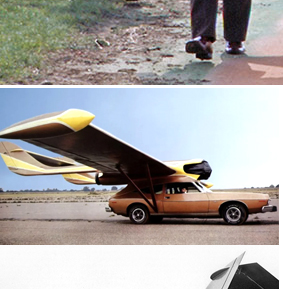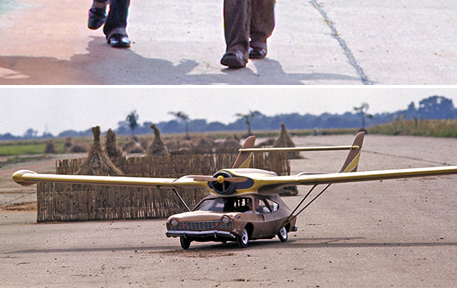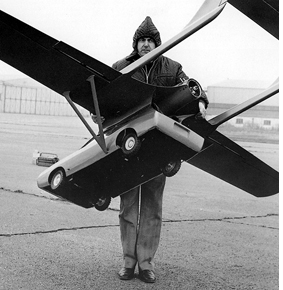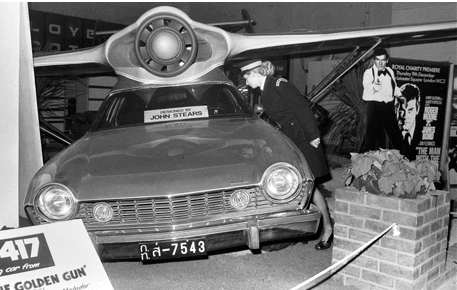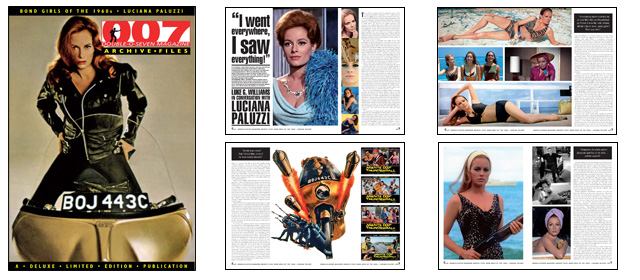|
 |
From the Archive
007 Issue #13 (1983) |
|
|
|
|
 |
|
Moving on to You
Only Live Twice (1967). Up to that time all outer space SFX were
compared to Stanley Kubrick’s 2001: A Space Odyssey (1968). Were
you aware that you were going to encounter problems of comparison between
your SFX and those in 2001?
Of course you could never hope to duplicate the SFX of 2001 because
of the limited time and money at your disposal. No, we didn’t give it a
thought really. What we did was pretty current; whereas 2001 was
supposed to be set 2001. We used techniques and hardware that was
contemporary at the time. In fact one of the ideas we had for doing the
interception (subsequently changed in the final film) NASA hadn’t thought
of, and they have developed it since then. I still have long talks with
NASA about things.
I believe the sequence involving the helicopter flight over the
volcanoes contained a degree of model work, together with
Wing Commander
Ken Wallis’ ‘Little Nellie’.
Yes, I’m still very great friends with Ken. In fact I’ll be seeing him
shortly. |
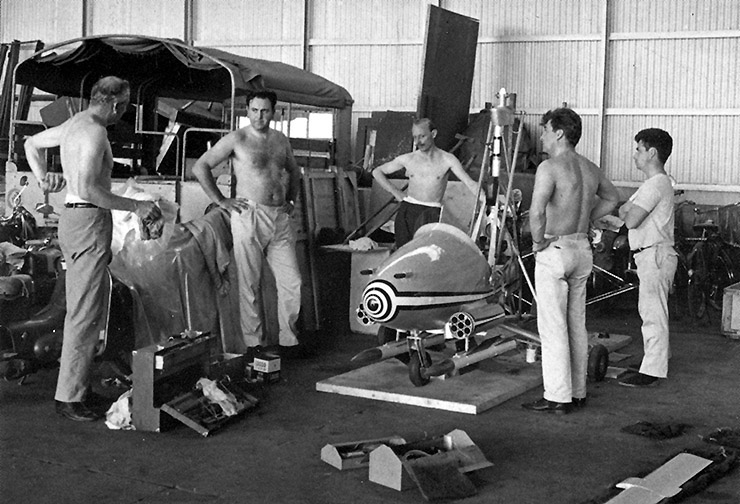 |
|
ABOVE: [L-R] Wing
Commander Ken Wallis (designer and pilot of ‘Little Nellie’), John
Stears, Bert Luxford, Joe Fitt and an unidentified technician
assemble the Wallis WA-116 autogyro in Japan ready for filming on
You Only Live Twice (1967). |
|
|
|
How much of the gadgetry was real on ‘Little Nellie’?
Nearly all the rockets were real, and the sidewinders – only the
machineguns were pyrotechnic FX, and certainly ‘Little Nellie’ could fly
with all those gadgets for real. But before her missiles could be fired in
actual flight I had to carry out a significant number of calculations and
tests. I had visited Ken at his workshop at Reymerston Hall where we had a
long discussion about how exactly we could attach all the missiles and
gadgets to his autogyro. There were a lot of factors to be considered,
like none of the additions should get in the way of the landing gear;
affect the slipstream of the aircraft or the aircraft weight. Being an
aircraft buff myself, Ken and I worked extremely well together from the
word go. Incidentally, Ken also made all the components for his flying
machines himself, being not only an accomplished pilot but also a superb
engineer. His workshop was an Aladdin’s cave!
Everything I need to do
the job had to be handmade. Nothing existed from stock! The missiles were
a problem, inasmuch they had to fire in a straight line ahead of the
autogyro, which would be doing around 120 knots. The missiles had to have
the power to accelerate away from Little Nellie’s flight line, and also
there had to be no chance of the aircraft catching the missiles or them
turning back to hit her. I was not concerned about the cluster missiles as
they were a known ballistic, and I had used the Icarus rockets before with
various types of exploding payloads of my own making. But the two long
air-to-air missiles were an unknown factor. I had to devise them from
scratch. My problem was, they had to be lightweight and stable in flight –
not an easy combination to achieve. I made a drawing and had Ken check it
out to see if the autogyro could handle two of them in the position
indicated in my drawing. |
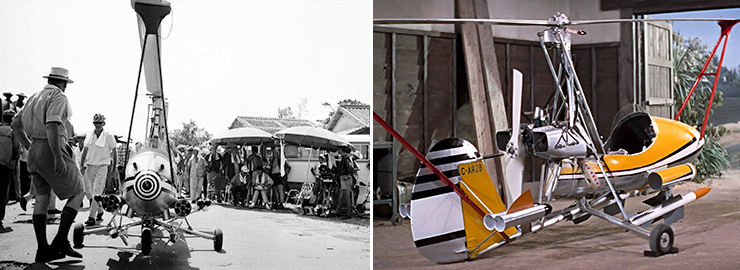 |
|
ABOVE: (left) ‘Little Nellie’ on location in Japan and (right) on
set back at Pinewood Studios. BELOW: A production drawing by
Michael White showing John Stears’ modifications to ‘Little
Nellie’. |
|
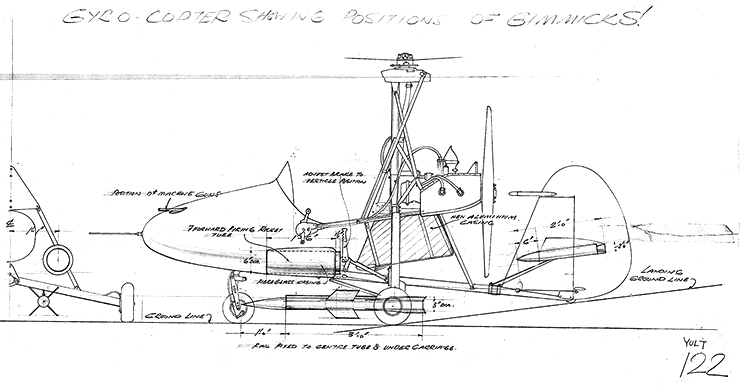 |
|
|
Getting the okay from
Ken, Bert Luxford (part of my SFX team) went ahead and made our prototype,
which when completed gave me the exact weight factor necessary to
calculate how much thrust I needed to get direction, speed and stability
required. I was looking for a one-to one thrust weight ratio or better,
with duration of at least eight seconds burn time. There was no time to
develop a rocket motor myself so I had to use what was available. The only
choice was Shermuly’s Line Throwing Rocket, which provided around seven
pounds of thrust. I could arrange four of these in the tail of the
missile, which gave me 28lbs of static thrust. The missile with the rocket
weighed approximately the same.
Now the moment of truth. Did I have enough power? Did I have the centre of
gravity correct? How straight would it fly – if at all? Bert had built a
launching ramp and installed it on the roof of the art department building
at Pinewood Studios. I remember it was after lunch. The day was grey with an
overcast sky. There was no wind. Perfect for a first firing. Other SFX
team members Jimmy Ackland-Snow
(1905-1975) and Joe Fitt (1924-2002) were also there to watch. We
were facing toward the end of Black Park’s pine trees – which run the
perimeter of the studios’ fence – so if the rocket overshot the lot it
would get stopped in the trees, which were wet, and wouldn’t cause a
problem. |
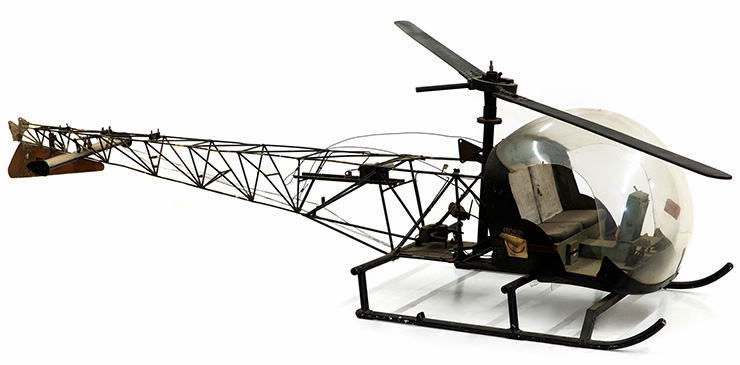 |
|
ABOVE: One of the
models built by John Stears’ team for the aerial battle between
SPECTRE and ‘Little Nellie’ in You Only Live Twice (1967).
|
|
|
|
There was some set construction going on to the right of us, well out of
our line of fire, and in shouting distance. Everything was ready. I called
out to the riggers on the set being constructed, ‘Fire in the hole!’ They
acknowledged, ‘OK John!’ Ten, nine, eight, seven, six, five, four, three,
two, one – fire! I pressed the ignition button. The missile paused for a
moment – then off it went! No problems, perfectly straight, no wobbles, as
if designed by NASA! It was flying exactly where it was supposed. The burn
time was perfect the motor stopped. But instead of the missile nosing over
and coming down, it stayed exactly the same height and made a perfect
right turn through 180 degrees then straightened out – coming back toward
us at 150 mph! One problem was, the construction crew were in the way –
and they couldn’t see it coming. We all yelled out for them to take cover
and get out of the way. I don’t know where I thought they could go – they
were on scaffolding! As luck would have it the missile sailed past them
about 30 feet away and landed at the bottom of the building we had
launched it from!
I heard the construction crew talking later, discussing how clever the
effect boys were, ‘They even make their own guided missiles!’ If only
they’d realised. |
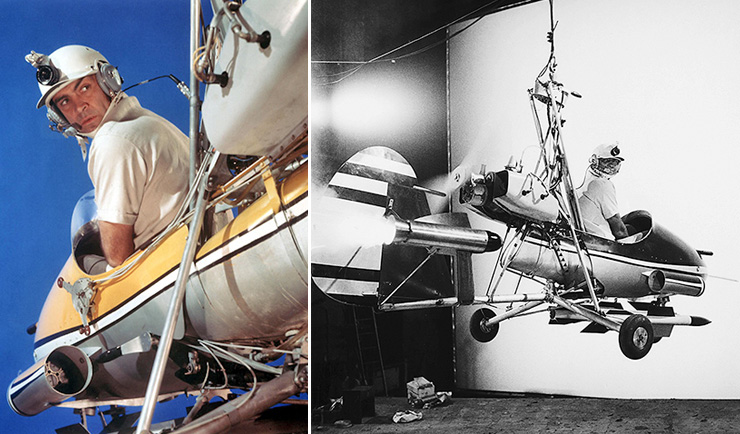 |
|
ABOVE: For the shots
showing Sean Connery flying ‘Little Nellie’, the actor was filmed
against a blue-screen with the autogyro suspended in the studio
and intercut with the footage captured in Japan and Spain with the aircraft
flown by Wing Commander Ken Wallis. The aerial footage was filmed
by cameraman
Johnny
Jordan who had a foot sliced off by rotor blades from one of
the SPECTRE helicopters, which then crashed into to the mountain
side. Although Jordan’s foot was reattached, it was so badly
damaged he decided to have it amputated and replaced with a
prosthetic tin leg. Jordan returned to film the spectacular aerial
sequences in On Her Majesty's Secret Service (1969), which
were mostly achieved with him suspended in a special rig beneath a
helicopter that allowed him an unbroken 360-degree field of
vision. Whilst acting as Second Unit director on Catch-22
(1970), John Jordan was killed when he fell out of an aircraft as
it banked without warning – he’d uncoupled his safety harness to
get a better shot! |
|
|
|
I imagine the Ninja
attack on Blofeld’s volcano headquarters in You Only Live Twice
must have entailed very detailed preparation?
Yes. I mean this is where Bond started getting really extravagant in terms
of sets and things, and you couldn’t really control things as much as you
wanted to because, although I was in Japan on location, I had to leave
pretty early to come back and set up the volcano shot, so you’re leaving
things with other people, you can’t avoid it, but one would have thought
it better if we could have had more time. But it was a time when returns
on investment had to be fast, labour rates were sky-high and we had to cut
corners on time.
And of course with 2nd and 3rd units filming different sections,
presumably there wasn’t the close communication that was a part of the
earlier films?
Well, it started getting difficult.
You worked for Harry
Saltzman on a film called Toomorrow (1970), which I believe was
only screened once and then withdrawn due to a legal argument. But it was
supposed to have had quite brilliant SFX in the sci-fi style?
Well it was a bit like E.T. the Extra-Terrestrial (1982) really,
although we didn’t have an ET like E.T. I think actor Roy Dotrice
played the part, but yes there were good FX. |
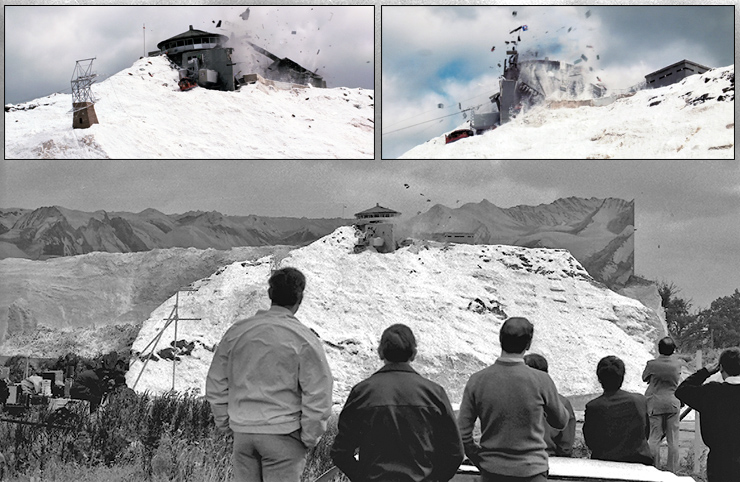 |
|
How big was the model of Piz Gloria in On Her Majesty’s Secret
Service (1969)?
I’m not sure, not too big, about the size of this room, I think about 1:48
scale.
Were any of the helicopters in the attack on Piz Gloria sequence
models?
Yes, for certain scenes.
Were they more complex than the model used in From Russia With Love?
No, the same thing. |
|
|
|
ABOVE: Scaramanga's
(Christopher Lee) flying car was achieved via the combination of
using a miniature and a modified AMC Matador Coupe, which had
wings and a propeller attached (centre left). The radio-controlled
miniature is seen in The Man With The Golden Gun (1974) as
the car takes off after Scaramanga out manoeuvres James Bond
(Roger Moore), who is chasing in a red AMC Hornet. The full-size
AMC Matador was displayed at the 1974 Earl's Court Motor Show
(bottom right) with John Stears receiving a credit on the car for
its design, and he also attended the Motor Show. |
|
|
|
Moving to The Man
With The Golden Gun (1974), the final James Bond film you worked on –
what was your biggest problem on that picture?
The biggest problem was with the aircraft. The problem was I was working
with a full-sized aircraft and I was basing everything on the power I
could fly the model with, and I was given the specification of an American
jet engine that would do the job, and they were two months late delivering
the engine. And when it did finally arrive there were so many problems
with it, it just wasn’t on. It was a prototype, and I had to change
everything at the last minute and we just got away with it. The power we
eventually had was so marginal for the type of aircraft that if the
barometric pressure was high I couldn’t get it off the ground, but if it
was too low, i.e. a stormy day, I would get uplift and I could fly it – so
we just got away with it!
You’ve just finished working on The Hound of the Baskervilles
(1983). What FX did you supply for that production?
Well, backups on the dogs. We had six hounds of various sorts, but it’s
not our picture, we were just asked to go in and help with the hounds.
Now that you are freelance and have your own company you must get a lot of
offers for different projects. What makes you choose one film in
preference to another?
Oh well, I’ve been doing this now for nearly 30 years and I don’t want to
know if there are going to be problems with the crew, an inexperienced
crew, or insufficient money on the table or not enough time. But I’m in
the situation now where I’ve really got to do my own picture – there’s no
question about that. I’ve been involved in making movies for other people
for so long that I’ve got the opportunity now and that’s going to happen
next year (1983), we start shooting around about June. |
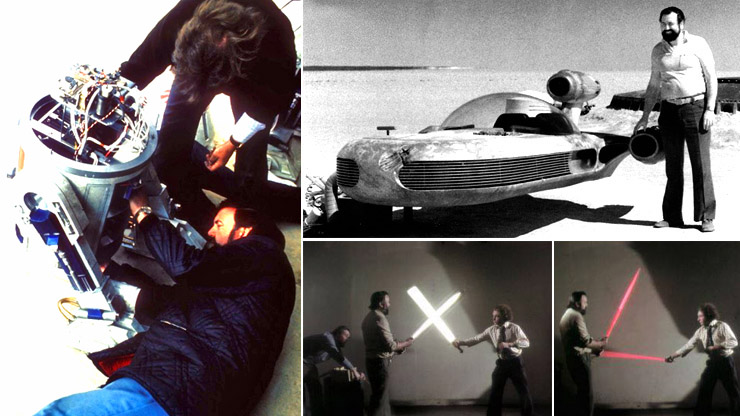 |
|
ABOVE: ‘A long time
ago in a galaxy far, far away...’ John Stears’ work on Star
Wars (1977) would win him a second Academy Award (shared with
the team from Industrial Light and Magic), and a Saturn Award
(shared with John Dykstra). John's work on Star Wars was
predominantly on the practical on-screen effects - such as a
radio-controlled R2-D2 (left), Luke Skywalker's land-speeder (top
right), and early tests for the light-sabres (bottom right). John Stears would also be nominated for a Saturn award in 1982 for his
work on Outland (1981) starring Sean Connery.
BELOW: Special Effects Wizard John Stears with one of his
highly-detailed Outland (1981) models, and (right) at home
with his Saturn Award and two Oscars. |
|
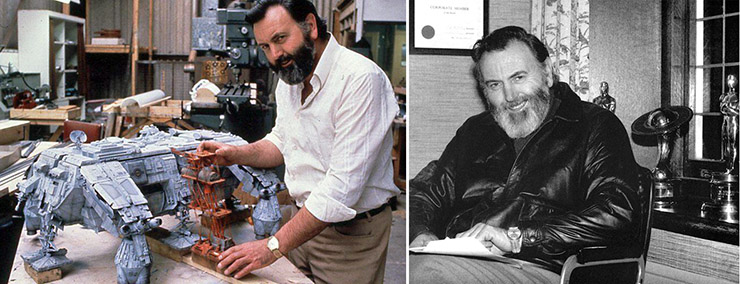 |
|
|
Is the film going to be in the Star Wars mould?
Well, it’s going to be entirely different – but you’ll just have to wait
and see.
In your career you’ve worked with American SFX technicians and American
film crews – is there any difference in the way each other work?
No. They learn from us (laughs). No, joking apart, they got involved with
the computerised camera, which works extremely well and all credit to
them, but on the physical effects side, they had that gap when they went
into TV and learnt from us. In fact I was in Hollywood recently and they
are still behind us. Their pictures are still coming here for the FX.
With the success of films like Star Wars (1977) and the general feeling
that the British are the best SFX technicians in the world, it seems
strange there is still this reluctance to invest British money in films?
Well, I think I may be able to reverse that.
I take it you’ve got around that problem with your upcoming film?
Yes, that’s right, it has totally British backing. But on this question of
backing, I think you could get more British money in films – but of course
the biggest problem is, unless you have a hit in the States the film will
be a flop financially. And how do you get your film on screens in the
States because American investment controls the theatrical circuits. |
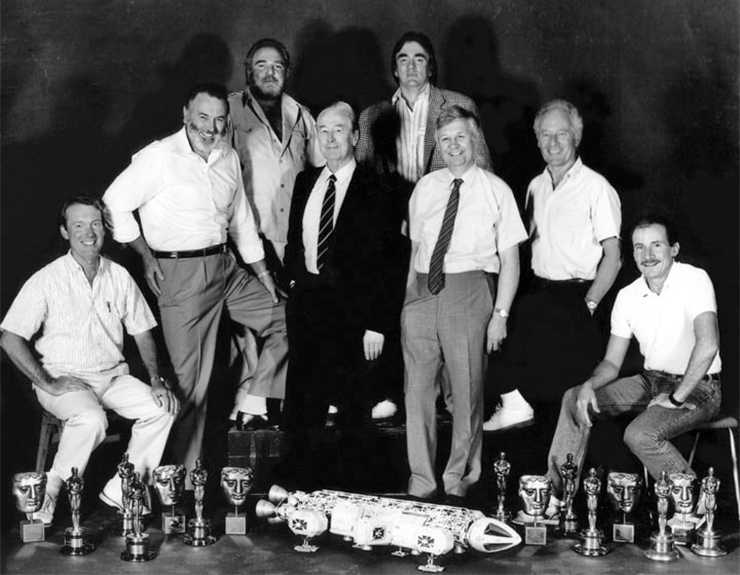 |
|
ABOVE: A WINNING
TEAM! - After leaving the James Bond series in 1974, John Stears worked on the British science-fiction television
programme Space 1999 - devised by Gerry & Sylvia Anderson,
which ran for two series from 1975 to 1977. Among the other
talented technicians working on the series were three other Bond
film alumni, and multi award-winning special effects creators.
[L-R] George Gibbs (1937-2020) [Indiana Jones
And The Temple of
Doom (1984), Brazil (1985), Who Framed Roger Rabbit
(1988)]; John Stears; Kit West (1936-2016) [Raiders
Of The Lost
Ark (1981), Return Of The Jedi (1983)],
Charles Staffell (1915-1999) [Dr.
No (1962), From Russia With Love (1963), Goldfinger
(1964), Thunderball (1965), You Only Live Twice (1967), 2001: A Space Odyssey (1968), On Her Majesty's Secret Service
(1969),
Diamonds Are Forever (1971), Live And Let Die (1973), Superman (1978),
Octopussy (1983), A View To A Kill (1985), Aliens
(1986)]; Brian Johnson (1940- ) [Alien (1979), The Empire Strikes
Back (1980), Aliens (1986)];
Roy Field (1932-2002) [Dr.
No (1962), From Russia With Love (1963), Goldfinger
(1964), Thunderball (1965), You Only Live Twice
(1967), On Her Majesty's Secret Service (1969), Diamonds
Are Forever (1971), The Man With The Golden Gun (1974),
The Omen (1976), Superman (1978)];
Derek Meddings
(1931-1995) [Live And Let Die (1973), The Man With The
Golden Gun (1974), The Spy Who Loved Me (1977), Superman
(1978), Moonraker (1979), For Your Eyes Only (1981),
Batman (1989), GoldenEye (1995)];
Richard Conway
(1942-2021) [Indiana Jones And The Temple of Doom (1984),
Brazil (1985), Little Shop Of Horrors (1986)]. |
|
|
|
|
|
|
|








